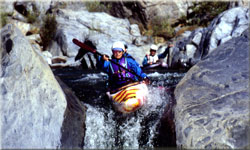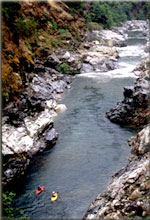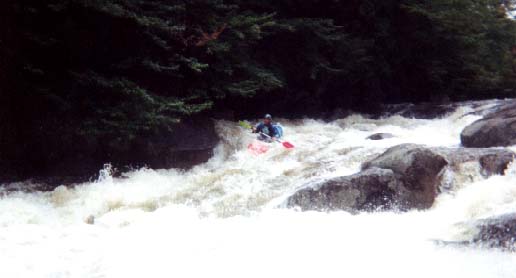|

|
Force: There are two basic physics principles that could be said to power the sport of Kayaking. They are Newton's second and third laws of motion, force equals mass times acceleration and for every action there is an equal and opposite reaction, respectively. A kayaker will place his paddle in the water and pull backwards in order to propel himself. While the paddle is being pulled back, it is exerting a force on the water and because of Newton's third law of motion, the water is simultaneously exerting an equal, but opposite, force on the kayaker. Since the kayaker was pulling backwards the force exerted inversely onto the kayaker is in the forward direction. Due to Newton's second law of motion, the force exerted on an object equals the mass of the object multiplied by it's resultant acceleration. Thus, if one were to divide the numeric value of the force by the mass of the kayak/kayaker combination, he would get the resultant acceleration that the boat experiences. (ie: If the kayak and kayaker total a mass of 50 kg and they exert a force against the water (and thus the water exerts against them) a force of 150 N then one would need to divide 150 N by 50 kg in order to find the acceleration, 3 m/s^2)
|
|
Torque: Though Newton's Laws explain the basic concept of how a kayaker is able to propel himself forward, there is a lot more going on. Including torque. Torque ( ) is the reason why the kayak swings in the opposite direction of each stroke. If a stroke is done on the right side, the kayak rotates counter-clockwise, but if the stroke is done on the left, the kayak rotates clockwise. This is because that while a stroke is taking place the paddle acts as a lever arm for the vessel. Torque is the length of the lever arm times the perpendicular force exerted on the arm. So if the distance from the ship's center of gravity to the blade is "r" and the force exerted on the blade is "F" and the angle between the force and the lever arm equals "a", then ) is the reason why the kayak swings in the opposite direction of each stroke. If a stroke is done on the right side, the kayak rotates counter-clockwise, but if the stroke is done on the left, the kayak rotates clockwise. This is because that while a stroke is taking place the paddle acts as a lever arm for the vessel. Torque is the length of the lever arm times the perpendicular force exerted on the arm. So if the distance from the ship's center of gravity to the blade is "r" and the force exerted on the blade is "F" and the angle between the force and the lever arm equals "a", then
 = r x F x sin(a) = r x F x sin(a)
Only the force exerted perpendicular to the blade has an actual affect. Thus the further from the ship that one places their stroke the greater "r" will be, the greater torque that will be made, and the more the boat will rotate from side to side.
| 
|

|
Crossing the Running River: One tactic of kayaking involves the canceling out of vectors to travel perpendicular to a river, tide, or any other flowing current. Suppose a kayaker is crossing a river that runs from north to south. He is located on the west bank at point P and wants to reach point Q, directly across the river (or tide or whatever) at a distance of 125 meters. The kayaker is able to travel at 5 m/s, and the current is running at 3 m/s. At this rate (according to distance equals rate times time) it would take the 25 seconds for the kayaker to cross. During that time, though, the current was also affecting the kayak, rushing him south, down the river, at a speedy 3 m/s. Thus he reached the other bank of the river, but 75 meters further south than he wanted. This can be avoided by kayaking at an angle to the horizontal. If he continues to travel at 5 m/s, and the river continues to flow at 3 m/s south, then by using the equation arcsin(3/5) = 36.869 degrees, it can be seen that the kayaker should travel his 5 m/s at 36.869 degrees north of east in order to arrive at the other bank with out having traveled further south. Looking at this in another light it can be seen that the kayaker has merely incorporated a vertical velocity (3 m/s north) to cancel out the current, and leave only a horizontal velocity (4 m/s east) to affect him.
|
As can be seen, many different aspects of physics affect the sport of kayaking. An in-depth knowledge of these rules and laws, concepts and theories, and how they apply to an activity, can give any competitor the edge in any sport, including kayaking. If you are serious about being a competitive kayaker, or even just want to improve your technique, I strongly suggest that you consider enrolling yourself in a physics program, perhaps at your local community college.
[
Sign my Guestbook] - [Read my Guestbook
]
[Guestbook by TheGuestBook.com]
|

